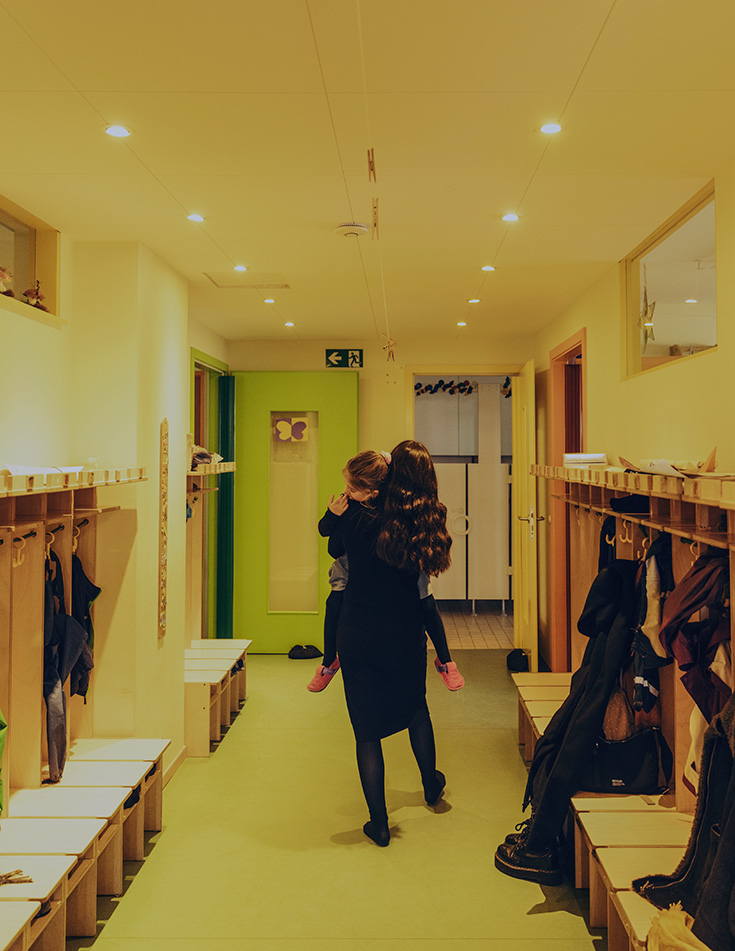When Kathrin Bock-Famulla looked for a daycare option for her one-year-old, she was called a Rabenmutter. Literally, it means “raven mother,” a derogatory term for those who return to work “too early,” like ravens who push their progeny out of the nest before they can fly. This was in 2000, when there were no daycare spots for children under three in the small German town of Melle, where Bock-Famulla lived.
But, just thirty kilometres away, in Bielefeld, the city where she worked as a university researcher, many colleagues had children the same age as hers in care. When she got a group of parents together to request funding from the town of Melle to support such a centre, however, she got a terse response. “They said no, it was not necessary.” In fact, she was told that, as an academic couple, she and her husband should be able to afford private care.
Bock-Famulla kept pushing—and the reaction was fierce. Opponents argued in the local paper that children under three who attended daycare would be psychologically damaged, she remembers, more likely to become addicted to drugs when they were older. “You permanently had the feeling that you are a bad mother if you wanted to work,” says Bock-Famulla.
Government policy at the time was designed for traditional households with male breadwinners, assuming that women would stay home with young children for the first three years. That contributed to Germany having one of the lowest birth rates in the region and a high rate of women either working part-time or not returning to work at all after having a child. But that was quickly becoming inconsistent with societal shifts toward supporting working mothers. The opposition to her proposal was particularly confusing for Bock-Famulla—a senior expert in early childhood education at the Bertelsmann Foundation think tank—since she knew the federal government was looking for ways to expand child care access.
Changing Bock-Famulla’s situation took convincing a local provider to expand his daycare centre to include spots for just three children under three and working with other parents to start their own centre to ensure ongoing access. Changing the situation for families across Germany took a federal election, new legislation, and a battle in court.
Over the past twenty years, huge social and policy changes have significantly remade child care in Germany. Angela Merkel led a newly formed coalition government that expanded federal support for daycare in 2005. Then, in 2008, the Childcare Funding Act was passed, granting parents with children over the age of one the legal right to subsidized daycare spots beginning in 2013. This was backed with robust funding: the federal government committed the equivalent of nearly $4 billion to support states in expanding daycare capacity over the five years ahead of the law coming into effect. There was also a commitment to fund ongoing costs: $1.1 billion per year since.
While this investment substantially expanded access, it was enshrining the right to child care in law that changed the game for parents. In 2016, a federal court affirmed this right when three mothers from Leipzig sued their city for not providing daycare spots for their children. The court ruled that the city had to pay damages to the parents for income lost when their inability to place their kids in daycare made it impossible for them to work. “It makes a huge difference if families know they can sue the government in order to get this right,” says Agnes Blome, a postdoctoral fellow in political science at Freie Universität Berlin. “They have a very different standing.”
Today, many Canadians hope that this country is on the brink of a similar transformation. Fifty years after the Royal Commission on the Status of Women recommended a national, government-funded child care plan, Justin Trudeau’s Liberals pledged to deliver one in their 2021 budget. They have promised to make a long-term investment to support families, forging agreements with provinces and territories to fund $10-a-day child care across the country by the 2025/26 fiscal year.
While provinces and territories set child care policy, the federal government is pushing change through bilateral funding agreements. The feds can’t unilaterally tell provinces to reduce daycare fees, but they can attach conditions to the influx of money offered up to reach this goal. Each province or territory has its own agreement: the broad goal is to bring fees down to $10 per day, but the way each jurisdiction pursues this may vary. For instance, the agreement with Nova Scotia says funding is for regulated full-time spaces for kids under six while the agreement with Manitoba says fees for kids under seven will be $10 per day.
Canadians have seen attempts at a national child care plan before. Paul Martin’s Liberals put one in place only to see Stephen Harper’s Conservatives scrap it. This points to one big constraint on child care policy in Canada: it is a policy—subject to changes in political winds and existing only conditionally. It can be, and has been, undone by a subsequent government.
As Canada embarks on a new push for child care, what can we learn from a country very much like ours—a highly urbanized, high-income federation whose national government funds a program that states and municipalities are responsible for delivering—that is years ahead in pursuing this goal? And what can we glean about the potential pitfalls and how to avoid them?

Canadian parents spend, on average, a quarter of their income on child care. Before their new agreements with the federal government, just four jurisdictions in Canada—Manitoba, Quebec, Prince Edward Island, and Newfoundland and Labrador—had set fees that covered at least half of their child care spots, keeping costs somewhat in check. Other provinces and territories reduced fees for particular groups, subsidizing low-income or single parents, for instance—though these programs fall short of what families need.
With the lowest regulated child care fees of any province or territory in Canada, Quebec has seen parents access child care at the highest rates in the country, both preceding and during the COVID-19 pandemic, at 78 percent in 2019 and 75 percent in 2020. But, outside of Quebec, “high fees are a driving force in how likely parents are to stop using childcare,” write David Macdonald and Martha Friendly from the Canadian Centre for Policy Alternatives (CCPA) in their annual child care survey of 11,000 providers in thirty-seven cities across Canada.
Parents with children under three are most likely to say they have difficulty accessing care, according to Statistics Canada, with 59 percent reporting that affordability is the issue. Fees for children under eighteen months are the highest, ranging from a median of $181 per month in Quebec to $1,866 per month in Toronto. An annual cost of over $22,000 a year, this represents nearly half of the average income in Toronto.
Costs for toddlers, who range from eighteen months to three years old, aren’t much lower, the CCPA report found: Toronto leads again, with median monthly child care fees of $1,578; the GTA as a whole is not far behind; and Richmond, BC, follows at $1,300.
Cost isn’t the only constraint. Even where fees are more affordable, securing a spot can be tough. Before the pandemic, 596,612 kids under six in Canada had a regulated child care spot—that’s about 27 percent. Access across the country is uneven: only 16 percent of kids in this age group had a spot in Saskatchewan versus 42 percent in Quebec. COVID-19 complicated access further as some centres shuttered—one of many factors contributing to falling rates of children under six in care between 2019 and 2020.
Child care across Canada falls into two broad categories: regulated and unregulated. Regulated care includes daycare centres and home child care by licensed providers while unregulated care covers everything else—care by a babysitter, family member, or nanny. (Because these are informal arrangements, it’s tough to reliably estimate the number of kids in this kind of care.) Since child care is under the jurisdiction of provinces and territories, each has its own approach, but they broadly have landed in the same place: a mix of for-profit and not-for-profit spaces rather than government-run facilities. Nearly two-thirds of facilities are not-for-profit, with for-profit care making up most of the rest. Unlike in Germany, there is no entitlement to a child care spot, and as a result, child care is seen as a private responsibility—one that parents are left to figure out on their own.
Herleen Kaur Arora and her partner, who live in Toronto, are trying to game out the timing of having a second child. Even with two stable jobs, they can’t afford the roughly $2,000 per month for a second daycare spot. One year of this fee is “equivalent to [tuition at] a college or university for a number of years,” she says. Arora feels lucky to have found a spot for their first child at all. When she started to share the news that she was pregnant, in January 2020, the first thing friends and family often responded with was: “Have you put yourself on a list for daycare?”
Arora did a few daycare visits right before the first lockdown hit; afterward, she called centres in her neighbourhood to be put on a list. Arora’s daughter was born in June 2020, and the following March, it occurred to Arora that she hadn’t heard back from any of the centres she had spoken to the previous year. She was excited to get back to work the next May, but as she started following up, all five centres she inquired at told her there was no space for her daughter. The most expensive option—a private, for-profit centre—said it could give her a spot in September. Not only was it several hundred dollars more every month than the most affordable option in their area, it also meant Arora had to take four months of unpaid leave as she waited for her child’s spot to open.
In BC, subsidies have helped Karen Muir with the cost of care, especially as a single parent. But finding child care for her youngest was a struggle in Prince George, where only 26 percent of kids under five have a spot, according to a 2018 CCPA report. The report found that 776,000 children across the country live in “childcare deserts”: postal codes where there are at least three children for each child care space. Some of the lowest rates of access were in places as varied as Saskatoon, Brampton, and Kitchener, each of which had just one space for every four to five children.
Muir lucked out when a new daycare centre opened up across town and took both her eight-month-old, Ellie, and her two-year-old, Amelia. The cost was high—$1,600 for each child—but provincial subsidies brought it down to $1,250 a month for both. Then, just a few months after it opened, it shut down temporarily in November 2020, and Muir was “freaking out.”
She enlisted her mother’s help full-time that winter, but her mother had to return to her farm, in Vanderhoof, an hour outside of Prince George, for calving season in March. Muir ran through a list of possibilities: working at home with a one-year-old and a three-year-old, sending them to live with their grandparents for a few days every week, or quitting her job and relying on social assistance. Every option was bleak. Muir says that “the additional consideration for me was, I’m losing years in the workforce, which . . . weighed on me because I know that, as women, we’re penalized for those years out of the workplace.”
Right under the wire, Muir found a centre that would take both Ellie and Amelia, one they have been able to stay at since. It was a huge relief, but the next round of stress is around the corner: her eldest is now on a wait list for after-school care for when she starts kindergarten in September—and the centre has already suggested that Ellie, who isn’t even three yet, get on a list for that too.
The federal government, for its part, has recognized that the high costs and lack of access associated with child care are keeping women out of the labour market. Last year, in addition to the child care investment, the Liberals announced a more modest investment in early childhood education to meet the growing demand for educators, which will presumably only accelerate as costs come down. The government will also continue to invest $2.5 billion over the next five years with Indigenous partners through the Indigenous Early Learning and Child Care Framework, which was created in 2018 to develop culturally appropriate care. The government frames it as a “hat trick”: creating child care jobs, enabling mothers to work, and investing in the next generation.
Within Canada, Quebec is a model of success. Two decades after the province implemented low-cost, set-fee care in 1997, the proportion of employed women with children under five went from 64 percent to 80 percent. More women work in Quebec compared with the rest of Canada: 85 percent—on par with the highest rates of women working globally, according to Université du Québec à Montréal professor emeritus of economics Pierre Fortin.
But, two decades on, there are areas where the Quebec model has yet to deliver. “Far too few children receive education and care of good-to-excellent quality, and far too few disadvantaged children access the good part of the system and have their special needs attended,” Fortin wrote in a 2017 report to the House of Commons. “Improving quality in general and better responding to the needs of disadvantaged children in particular should be the foremost priorities for the future development of the Quebec system.”
Across Canada, many want a system that will do more than just create child care spots. Advocates are calling for a system that provides quality early childhood education, that compensates staff fairly in a notoriously underpaid field that is made up of 95 percent women, and that provides culturally competent care. The German experience proves that large-scale policy transformation is possible, but not without investment and staunch commitment to match.

After two decades of policy change, the average cost of child care in Germany is now equivalent to about $260 per month, and the federal government is looking to reduce this even further. Access to child care is backed by a legal guarantee—one tested by that landmark 2016 court ruling, which confirmed that the onus is on cities to ensure there are sufficient child care spots. The results of this investment are already visible: across the country, daycare participation rates of children under three have grown from 37.4 percent in 2009 to 64.3 percent in 2020. The country has also seen an increasing number of women working and an increased birth rate.
As in Canada, even though Germany’s federal government contributes to child care funding, it cannot dictate the terms, leaving implementation to states and municipalities. The country’s sixteen states all have different approaches to allocating funds. Historically, child care policies were in stark contrast between East and West Germany. In the German Democratic Republic, a socialist work ethos meant that many more women worked than in West Germany, and that meant there were many more child care spots—a legacy that is still visible today. While the west still lags behind the east when it comes to providing spots, the former is more likely to focus on quality of education. Throughout the country, left-leaning states are likelier to invest more in child care.
But, across the country, cost is a diminishing concern for parents. “The absence of for-profit providers [puts] the affordability issue on another scale,” says Ludovica Gambaro, a senior researcher at the University of Tübingen. “Even when it’s expensive, you still have waivers for families with low incomes. [Fees] never reach the level of Toronto, especially for babies and toddlers.”
Two models in particular have been lauded for going above and beyond federal requirements and providing free or low-cost child care: those in the states of Berlin and Hamburg. And, while both have greatly expanded access and contributed to more women in the workforce, they also hold lessons about the new problems that crop up amid rapid growth.
In an industrial-looking block in Hamburg’s central district of Altona, the windows into one unit break up the drudgery. Large teardrop-shaped cardboard cut-outs in every imaginable colour hang from the ceiling in one room; streamers and a mini–ball pit liven another. During the day, you can spot tiny people in the tiny chairs that fill the main room.
The building houses one of six Apoidea daycare centres, a midsize daycare chain in the city. This branch caters to children in two groups: one for those under three, on the ground floor, and another for kids three to six, upstairs. The centre has an atelier for kids to draw and paint (even on the walls, if they feel like it); a room for music; one for movement; another full of costumes to play dress-up; one with endless boxes of beads, pasta shapes, and the like for crafts; and a room full of plush cushions and rugs for rest. Biologists, artists, and musicians are frequent guests, talking about the importance of ecosystems or showcasing an exciting painting technique for the kids to try. Amid all this, child care staff are seen as guides, with kids themselves deciding what interests they want to follow day to day.
The centre is guided by the Reggio Emilia philosophy, a northern Italian approach that puts children at the centre of their learning. Once they are old enough to choose, kids attend morning circles where they decide what they want to do for set periods of time. Art and music are particularly important forms of expression for children who aren’t talking yet, says Frederik Siebeneichner, the pedagogical manager of six daycare centres under the Apoidea umbrella.
While this might sound like an expensive boutique daycare centre, it’s one of the 1,133 state-funded facilities in Hamburg. Germany’s second-largest city provides five hours of free child care to residents with children over the age of one every day, regardless of whether they work; depending on their incomes and working hours, parents can receive a voucher for more hours. An application has to be made between three and six months before a child needs a spot, and it is valid for a year. Parents update their employment and income statuses annually with the city-state, which can change their entitlements.
Hamburg has increased funding massively to meet demand, spending 8,232 euros ($11,845) for every child under six in 2018, an increase of 3,000 euros ($4,304) from 2012. Over the last ten years, the number of spots for children under three has more than doubled, from 12,393 to 28,429.
This support for parents was a major factor in Canadian Olivia Schulz’s decision to stay in Germany when she found out she was pregnant in 2017. She had moved to Hamburg from Toronto with her husband the previous year, and she started talking to her sister back in Canada about her experience returning to work after having a child. Schulz heard first-hand the child care struggle her sister had gone through in a small city in Ontario—the cost of daycare prompting longer hours at work to afford it, the exhaustion that came along with that, and how it stole time away from being able to parent her child. Hearing all that, Schulz says, “I have to admit, I was compelled to stay here.”
To be able to afford daycare in Toronto, Schulz knows she would have had to go back to a demanding job in sales. “I’d be missing out [on time with my child] just to earn enough money to break even at the end of the month.” In Hamburg, she was able to quit her sales job and use the time to figure out what was next for her career—something that would let her spend more time at home and flex her creative muscles.
Her daughter, Mila, is now in a Kinderladen, a parent-run daycare in Hamburg. Child care staff are there to support kids, but parents make the decisions about how it’s run at monthly meetings; prepare organic, sugar-free meals for the kids; and even rotate doing deep cleans of the centre. “It’s reassuring and it gives you a sense of control, which I think is one of the scariest things when you’re sending a little human out into the world for other adults to take care of them when they can’t communicate very well,” says Schulz.
This was particularly important to Schulz after her first experience enrolling Mila at a chain daycare when she was fourteen months old, in early 2019. Schulz quickly realized the centre was understaffed—at pickup, she noticed that staff were often filling out paperwork rather than spending time with children, and she wasn’t getting much information about how Mila’s day had gone. Schulz was a bit bewildered—Mila couldn’t talk yet, and Schulz had no way of knowing whether she had eaten or slept. “Most of the time I picked her up she had purple eyes,” says Schulz. “She was so tired—she just looked like a mess.”
One key factor limiting the growth of daycare centres across the country—and an important issue for Canada to anticipate—is a shortage of qualified child care staff. Early childhood educators are some of the most sought-after workers in Germany, with staffing shortages across the country. A recent study by trade union Vereinte Dienstleistungsgewerkschaft and Fulda University estimated that Hamburg is lacking about 4,000 child care workers, an average of 3.5 employees per facility. In a German Institute for Economic Research report based on national survey data, eight of ten child care workers said that they were stressed because their pay was inadequate, and they were less satisfied with their jobs than elementary school teachers were.
Siebeneichner, at the Apoidea centre, recognizes that it’s a tough job that demands a lot from staff: pedagogical knowledge, emotional intelligence, patience when dealing with demanding parents. There are a variety of routes to qualify, from two-year vocational diplomas to bachelor’s degrees. And the high demand in the labour market means people landing in these jobs are not often prepared: Siebeneichner has employees who don’t have the grammar skills necessary to write coherent development reports for parents. And the lack of staff often means there is no time during the day to step away to perform administrative tasks, leaving child care workers overworked and overwhelmed.
Child-to-staff ratios are a key indicator of quality, says Bock-Famulla from the Bertelsmann Foundation, which recommends a ratio of one worker per three children three and under. In a research project conducting interviews with child care workers across the country, Bock-Famulla heard repeatedly that “there is no time, no possibility” for child care staff to provide individual support to children.
That’s exactly what Schulz was concerned about. “I mostly spent the time sitting at home worrying about how she was,” she says. When Mila had a huge bump on the back of her head after being pushed by another child and staff advised Schulz to take her to a hospital at pickup—without having called Schulz during the day, immediately after the incident happened—Schulz was done. Luckily, she wasn’t working at the time and was able to stay home with Mila for another year. But it was wearing. She had suffered postpartum depression, and being far from her family was a further strain.
A year after she pulled Mila from daycare, she started to research other types of care. Schulz found a spot at a Tagesmutter, a small daycare run out of someone’s home that was also covered by the state government. The hours were more flexible than those of the larger daycare centre, and Mila was happier there. “At drop-off, she would jump into her [caregiver’s] arms,” says Schulz. “There was a deeper connection.”
That gave Schulz the opportunity to find balance again, and after Mila aged out of the Tagesmutter, Schulz found the Kinderladen. Choice in type of provider, not just in the size of a centre but also in its pedagogical approach, is a hallmark of the German child care system. Having options for what kind of care she could access with her public subsidy was huge for Schulz—she can’t imagine ever going back to a mainstream centre with her second child, due later this year.

The city-state of Berlin is at the vanguard of child care in Germany: in 2007, it made the decision to phase out fees entirely and become the first German state to provide free daycare for all children under six. This involved getting rid of a complex system that determined what rates parents would pay based on their incomes, to a maximum of about 400 euros ($574) per child monthly. The move to a universally applied voucher now leaves parents with just a monthly 23 euro ($33) bill for food. Since 2012, the state reports that 68,700 spots have been created, at a cost of 448 million euros ($642 million).
Daycare centres include larger child care centres and smaller facilities like parent-run Kinderladen. Since the state doesn’t run most centres itself, the model provides not-for-profit facilities with funding per child enrolled. Child care providers receive about 1,300 euros ($1,865) per month for each full-time spot for children under three.
The rapid expansion of publicly funded spots has been met with rapid uptake. While the population of Berlin increased by about 10 percent between 2011 and 2020, the number of kids under three grew by 19 percent in that time, and the number of kids in child care grew by 29 percent. The city attributes this both to increased uptake and to new families moving to Berlin, partly because of the policy change.
In theory, to access the system, parents fill out paperwork to demonstrate their eligibility, and then they apply to one of 2,663 state-funded facilities for a spot. In practice, it’s a bit more complicated.
When Sandra Sperber was pregnant, she started to pop in to daycare centres near her home, in the Berlin district of Pankow. Friends had warned her that finding a spot could be difficult—she’d have to put herself on four or five lists—but that she’d definitely find one in the end. Sperber had her daughter in May 2017, which meant that, when her daughter was ready to go to daycare at age one, she was entering her into daycare the first year that all state-funded child care spots in Berlin were free
of charge.
“It changed the demand,” says Sperber. “That was the first year when people really started to struggle.” In Sperber’s case, one of the centres she approached was clear that there was “no chance” she’d secure a spot by May. And she wasn’t alone. That same month, a group of parents and educational workers led a 3,500-strong protest calling for more spaces, among other demands. High interest in spots means parents often have to wait until August for places to open up, since that’s when children graduate from one daycare group (under three) to the next (three to six). Sperber’s daughter had turned one in May, and she had already gone back to full-time work as a journalist after seven months of parental leave. Her husband had taken over as their daughter’s primary caregiver, but it was time for him to go back to work.
In the end, Sperber cut her hours at work to 30 percent and enlisted support from her in-laws, who made the four-hour journey from the central German city of Kassel every other week to help out. “It was super frustrating because, up until that time, I thought it’s possible [to] have a career and have a baby,” says Sperber. And it put pressure on her relationship with her husband as they discussed who would stay home. “His colleagues were waiting for him to come back, and it’s harder for a father to say, ‘Well, I can’t come, I have to take care of the kids.’ So I did it, and that was also really frustrating.”
In her view, free daycare lifted a huge burden off parents in terms of the cost of having a child, but the lack of planning around how quickly demand would grow left some parents in a worse position. While two-thirds of children between one and three in the city were enrolled in child care in 2020, the Berlin senate is aiming to create 26,000 more places to address shortages by 2026. Existing child-to-staff ratios need improvement, according to the Bertelsmann report, which found that 94 percent of child care facilities in Berlin for kids under three do not meet the recommended one-worker-to-three-children ratio.
“Every day we receive applications for places, every day families make inquiries, and unfortunately we are unable to meet these requests,” writes Stefan Spieker, CEO of daycare provider Fröbel, which manages the largest daycare network in Germany, in an email. “Most of our centre’s managers stopped working with waiting lists since several of them have experienced up to a thousand registrations on the list.” The state is working on expanding spaces by providing both capital and staff funding, it’s just not happening quickly enough for some parents. And it’s an issue felt across the country as there is a shortage of over 342,000 spots in Germany.
For Sperber, this is where parents like her could contribute. While she sees the advantage of free daycare and is grateful to benefit from it, she believes that, if all parents don’t have access to a spot, a free model isn’t equitable. “Many parents who don’t get a spot, they paid for my daycare spot with their taxpayer money.” Parents like her can enlist the help of family, afford to pay a babysitter when they can’t find care, or take time off to find a spot. And she realizes that, compared to newcomers in particular, her language and cultural proficiency means she’s able to navigate a complex system with relative ease.
Gambaro, the University of Tübingen researcher, hypothesizes that the administrative burden is underestimated in the research on child care barriers. Especially for non-German speakers, the complex process of filling out paperwork, applying to several facilities, or even going to the youth office for assistance can be overwhelming. “We know from normal life that it’s hard to wash your hair if you have a toddler at home,” she says. “I sometimes would like to make a video when I’m running around those [bureaucratic offices].”
Immigrants access daycare at much lower rates—21 percent of immigrant children under three versus 43 percent countrywide—which can put children’s German-language skills behind when they start school. Gambaro’s research has shown that, when refugee women have children in care, they feel more integrated, have better language outcomes, and are more optimistic about joining the workforce.
Sperber would like to see those who really need free daycare get it first, rather than those who are able to navigate the system well enough to snag a spot. And she would be happy to pay to help that happen. “I would always argue for better education reform . . . instead of making [daycare] free.”
The German experience shows that investment in child care can result in a remarkable reorientation of society, transforming its commitment to parents by shifting child care from an individual responsibility to a social one. It has paid off in terms of women’s participation in the workforce, helped improve OECD educational rankings, and contributed to an increased birth rate. Combined with parental-leave policies, it has also helped redistribute responsibilities between mothers and fathers more equitably, and it has likely improved the quality of life families have access to.
There remain investments to be made at all levels of government to expand both the number of spots and the quality of care provided, including capital investments for new daycare centres, more training opportunities for future child care staff, and better access for marginalized groups like newcomers. A one-time, multibillion-euro investment from the federal government simply wasn’t enough—steady support is what keeps the system afloat.
For Bock-Famulla, one of the most interesting outcomes of Germany’s child care revolution is the shift from being called a Rabenmutter for putting your child in daycare to the belief that being in a child care centre is best—even for those as young as one. It’s seen as better for a child’s development and has normalized mothers going back to work when they want. “It changed within twenty years from one end to the other,” she says.
While that revolution opened up more choice for mothers in particular, the interplay with other policies made one previously available option less attractive: staying home with your child beyond one year. Parents received parental-leave support for three years before this change, but now, parental leave is one year, meaning that, when choosing to stay home beyond then, parents must take unpaid time.
This cultural change in believing that child care is the best option, coupled with policy changes like reducing parental-leave benefits, means there’s pressure to put your child in care rather than child care being one more option available to parents, says Bock-Famulla. It’s a perspective that Canadian governments may find useful to bear in mind as they develop their own plans for expanding care. For Bock-Famulla, the ideal to strive for is giving parents more choice. “It has to be the decision of the family how they care for their child.”
This story was supported by the 2021 R. James Travers Foreign Corresponding Fellowship through Carleton University.





